Happy Friday, everyone. According to xkcd, I am failing the future test. That is to say, by 2019, I will be unable to communicate data through infographics or create data visualisations.

Credit for the piece goes to Randall Munroe.
Happy Friday, everyone. According to xkcd, I am failing the future test. That is to say, by 2019, I will be unable to communicate data through infographics or create data visualisations.

Credit for the piece goes to Randall Munroe.
Last summer, the Supreme Court ruled that most of the Affordable Care Act, also known as Obamacare, was constitutional. The one exception, however, was the plan to force states to expand their Medicaid coverage. Medicaid is the government plan tasked with helping to provide health insurance to the poor. But between the poverty level and the income level for subsidies for the new state exchanges, there is a gap. That gap was supposed to be covered by the state expansion of Medicaid.
Because the states are not being forced to expand their coverage, there now exists state-by-state gaps in health insurance coverage. This excellent interactive graphic from the New York Times looks at the poverty and insurance coverage segregated into those states that are and are not expanding their coverage. A good number of those states with high rates of poor and uninsured are Republican, deep-South states. If you’re really clever, you’ll compare this map to my map from earlier this week about the Conservative Party. Notice any overlaps?

Credit for the piece Robert Gebeloff, Haeyoun Park, Matthew Bloch, and Matthew Ericson.
If you’re not a Boston Red Sox fan, what’s wrong with you? Well, okay, so long as you’re not a Yankees fan, you’re not that bad. Anyway, the Boston Globe looked at the 2013 Red Sox season. Game by game, inning by inning. And because Boston is now advancing to the American League Championship Series, and since they will probably face Detroit, here’s a screenshot of the great game that was Scherzer vs. Lester.
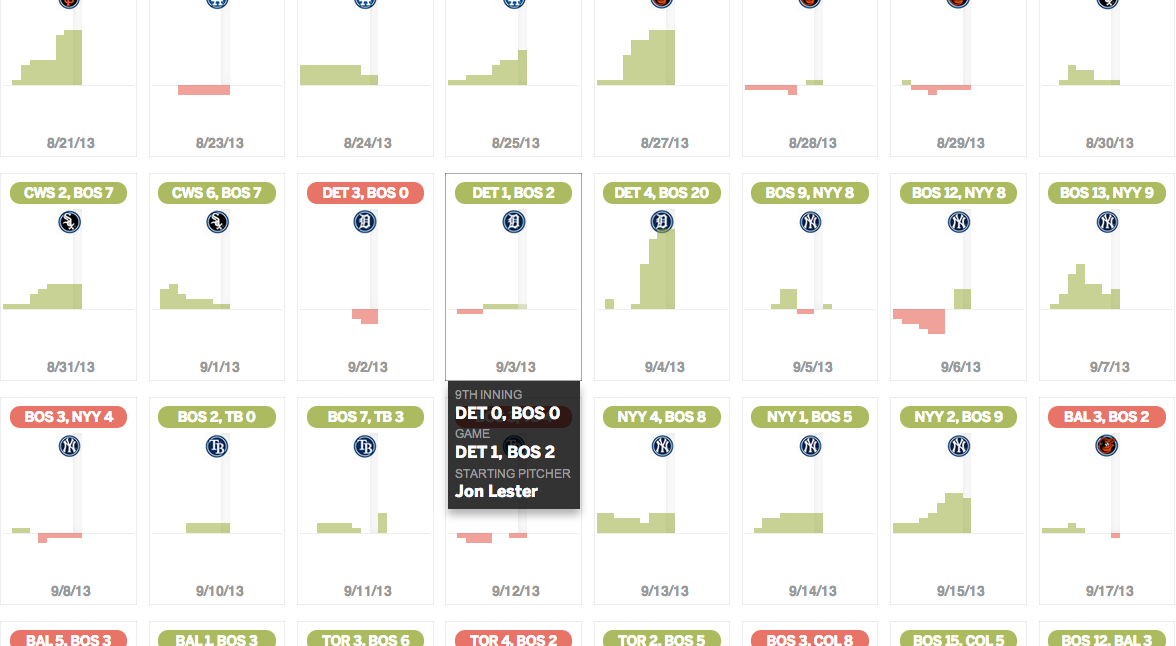
Credit for the piece goes to Chiqui Esteban.
We enter our second week of the government shutdown. Of course, blame for the shutdown falls largely upon a small number of conservative Republican members of the House, bolstered by Senator Cruz (R-TX) and his allies in the Senate. But we already know that there are a number of moderate Republicans who want to pass a clean budget resolution. So one way of looking at this new conservative faction is as a new minor party in a coalition government with Ted Cruz as Party Leader.
The idea is not mine. Ryan Lizza first wrote about the “Suicide Caucus”, a topic that Philip Bump expanded upon several days later. However, as a thought experiment, I was curious to see what would happen if this third party, a Conservative Party, would look in data visualisation terms. So here’s a quick stab at America’s newest third party.
The Washington Post put together this infographic looking at paydays for federal employees who will still be working during the shutdown, e.g. military service personnel. Of course, if the shutdown drags on, the paychecks for those still working would be delayed.
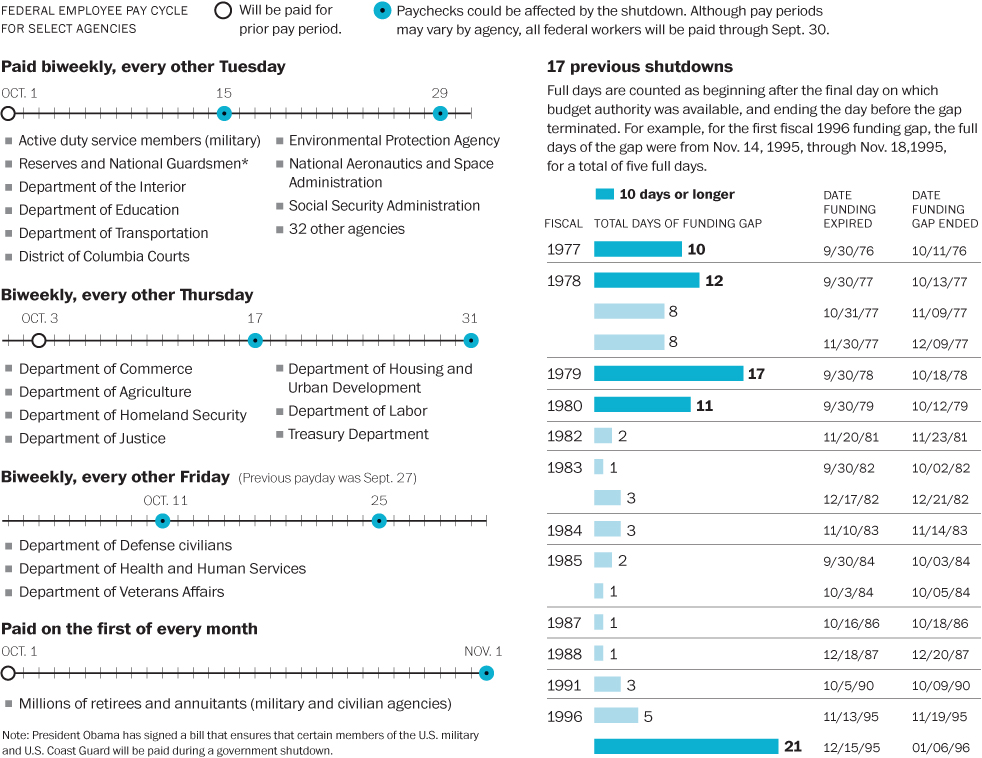
Credit for the piece goes to Lisa Rein and Todd Lindeman.
Some say bribes grease the wheels of business. But if that is the case, where are the greasiest wheels? This interactive piece from the BBC showcases an interesting story. It maps who has paid bribes and the value thereof. Then it looks at corruption in the different sectors of the country and which is perceived to be the most corrupt.
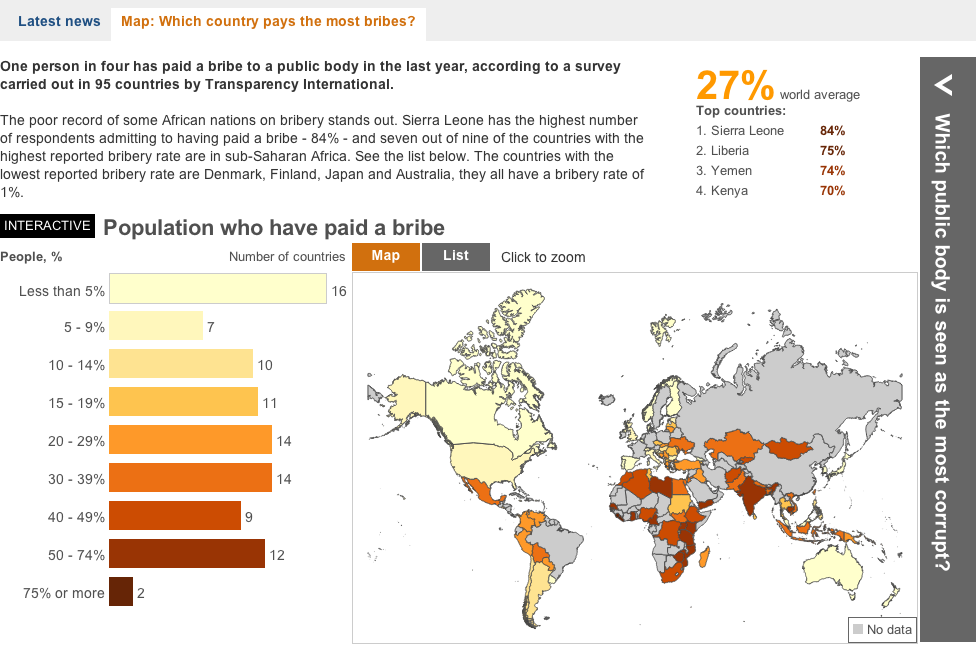
Aesthetically this is not the finest piece. Some of the most interesting countries to view are in Africa and Southeast Asia, i.e. geographies near the equator. Unfortunately the designers here chose a map projection that emphasises Siberia and Arctic Canada at the expense of those very countries. Also, where did Greenland go? I know that the ice is melting, but I don’t think it’s melted that quickly. Furthermore, if the user clicks the “List” option, he or she is presented only with a list of geographies. None of them are selectable nor do they encode data. So why is the list there?
In short, the interface is a bit clunky and strangely designed. Line lengths are too long and it looks ugly. But, there are two interesting things going on here worth noting. First the legend here actually does not just show the range for the choropleth, but it also encodes the number of countries that fall within that range.
Second, by clicking on a particular bin for the legend, the map filters for the selection. I think that from a design perspective, a lighter grey and a lighter stroke outline would have made the filtering a bit more prominent, but the idea is interesting. Unfortunately, I found no way of easily returning to an all-bin view of the map.
A piece for the BBC that misses a few, but also hits a few.
Credit for the piece goes to the BBC graphics team.
Tuesday was election day in New York (among other places) where voters went to the polls for the mayoral primary (among other positions). For those living underneath what I can only presume was a very comfortable rock, this is the whole Anthony Weiner comeback election. Anyway, a bunch of different websites, most tied to the New York area, were covering the election results. So I wanted to share just a few.
First we have the Huffington Post with the most straightforward presentation. Their table covers the main candidates and their results at a borough level and at a city-wide level.
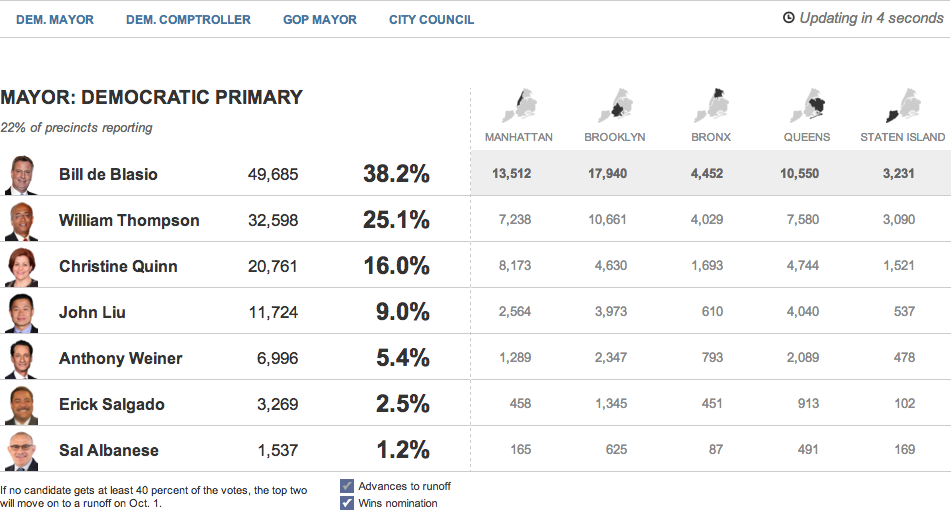
The second is from the Wall Street Journal. This uses a choropleth map with different colours assigned to a select few persons running—also the only ones with a real chance of winning. Tints of these colours in each district indicate how much of the district has voted.
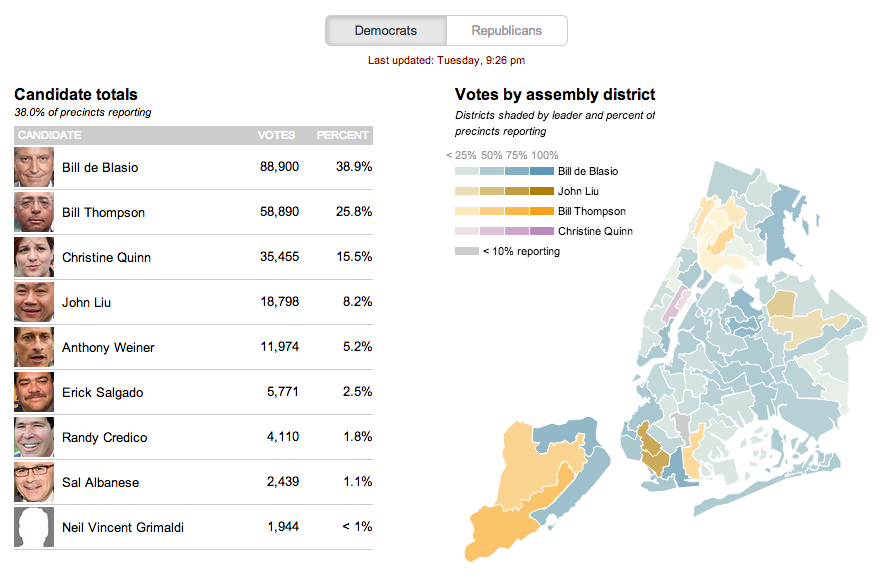
From WNYC we have our third example—another choropleth where different colours represent different candidates. However, unlike the Wall Street Journal, the colours here have only one tint. And instead of showing assembly districts, WNYC provides a further level of data and looks at precinct results. It does not represent the amount of the precinct that has voted, but rather whether the candidate is winning by a plurality or by a majority. Beneath the legend a second charting element is used; this details the breakdown of the vote by districts as separated into racial majority. This is an interesting addition that hints at filtering results by related data.

And that filtering brings us to the New York Times’ piece, which does offer filtering. It highlights districts on its maps—also precinct-level and not district aggregates—based upon the metric and the specific properties of said metric. In this case, I have chosen income. And the story of different voting patterns (at this particular point in the evening) based on income is quite clear. Look at Christine Quinn’s support.


Credit for these:
Huffington Post: Aaron Bycoffe, Jay Boice, Andrei Scheinkman, and Shane Shifflett
Wall Street Journal: the Wall Street Journal’s graphics team
WNYC: Steven Melendez, Louise Ma, Jenny Ye, Marine Boudeau, Schuyler Duveen, Elizabeth Zagroba, and John Keefe
New York Times: New York Times’ graphics department
…and not just any bankers but central bankers (the ones who establish policies at a national level), are rather under represented as this graphic from the Economist details. It is a nice use of small multiples with bar charts over time. Each bar is a 0–50% of the total membership of a central bank board and the share that is dark represents the number of women. Clearly for the countries selected not a single one has had a board of more than 50% women. Sweden and South Africa are the only two countries shown that have had 50% participation from women central bankers—though Norway and Denmark (for a period of time) have been consistently close.
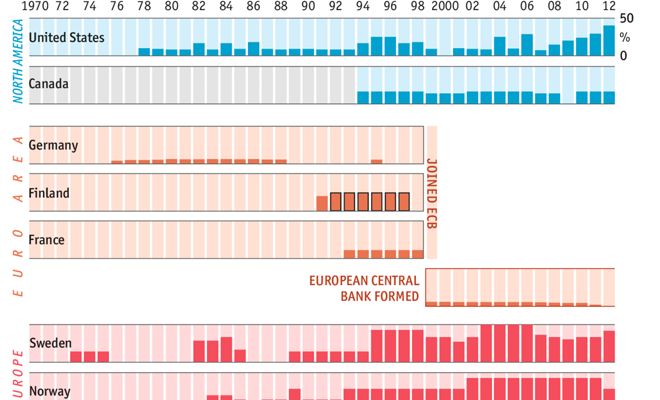
Credit for the piece goes to C.W., P.A.W., L.P., and P.K.
I was catching up on some news tonight and I came upon an unhelpful graphic that was supposed to be helping me understand the whip count (who is voting yes or no) for authorising the use of force in Syria. Below is the original graphic from Think Progress.
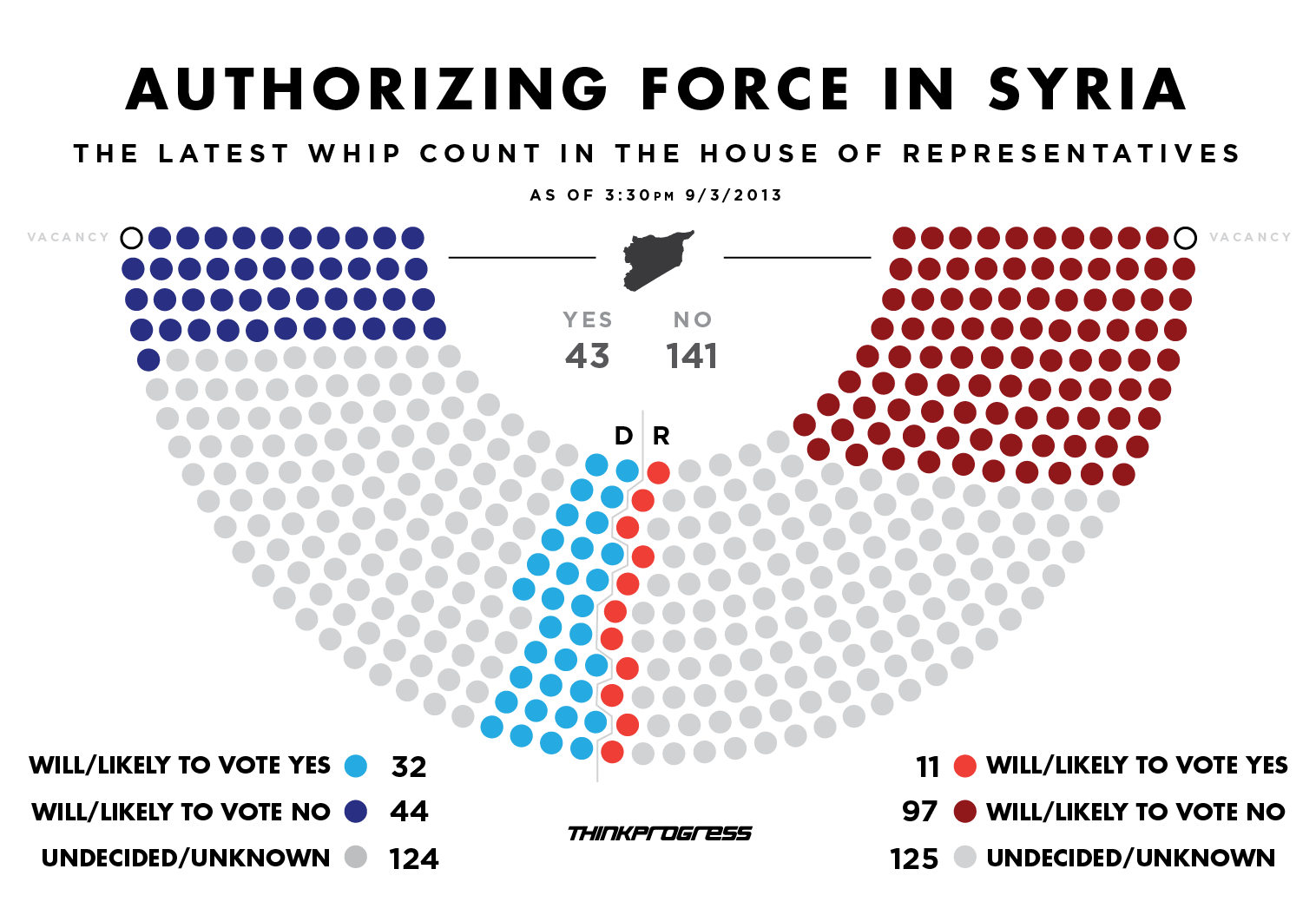
I struggled, however, to directly compare the yes and no votes. While I certainly understand that the splits within both parties are a fascinating subplot to the greater issue of will we bomb Syria, the traditional congressional arc visualisation is not helpful here. So using the same numbers, I simply plotted what is essentially a stacked bar chart. In truly heretical, i.e. independent, fashion I mixed the two parties together and placed them at either ends of the chart. The first to reach 50% wins. (If I were updating this live of course.)

Credit for the original goes to Igor Volsky and Judd Legum.
Admittedly I am a one-sport kind of guy; baseball is my thing. But I am at least aware that as Labour Day demarcates the border between summer and fall, it simultaneously signifies the beginning of the seasonal transition from baseball to football. (Though I am still pulling to see the Red Sox in October.)
This graphic comes from the New York Times from an article looking at the sports network ESPN. Specifically, the article focuses on the network’s strategy of working with smaller schools desiring national attention to fill in open spaces on their weekly broadcast calendar. In short, weekday nights are not big nights for college football; usually people watch their alma maters on Saturday. But, if your school is willing to make schedule adjustments, ESPN is apparently willing to throw you some money. This interactive bar chart looks at whether your alma mater (or in my case the only university I attended that had sports—yay art school) has begun to play weekday games.
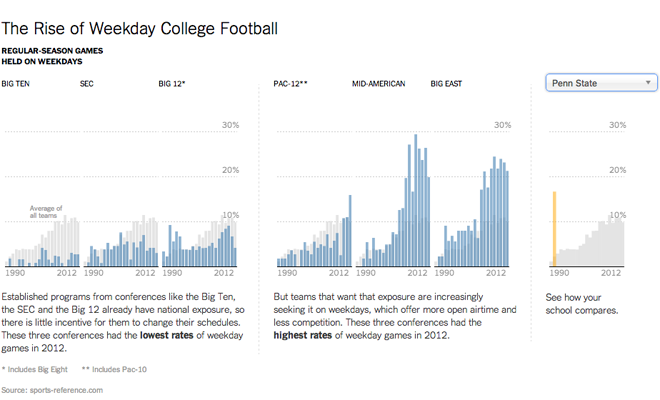
Credit for the piece goes to the New York Times graphics department.